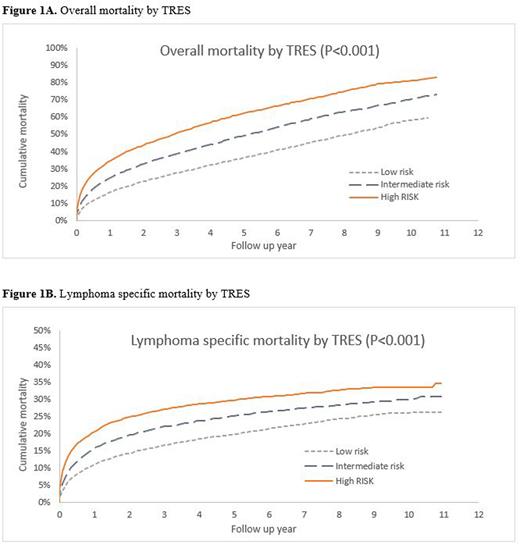Abstract
Introduction Comorbidities impact survival and tolerance of therapy in patients (pts) with NHL. Lack of a standardized measure and the complexity of available scores has hindered the formal assessment of comorbidities in pts with NHL. We previously developed an easy to use comorbidity score in pts with chronic lymphocytic leukemia (CLL), the CLL comorbidity index (CLL-CI; Gordon et al, CCR, 2021). The CLL-CI is scored by assessing medical conditions in vascular, endocrine and upper gastrointestinal categories. Scores range from 0 to 3. The CLL-CI has been validated in independent cohorts of pts with CLL (Rotbain et al, Blood Adv, 2022) but has not been evaluated in other NHL subtypes. We hypothesized that the CLL-CI would be associated with survival in NHL. As this study includes pts with other NHL subtypes, we now call the CLL-CI the three-factor risk estimate scale (TRES).
Methods Our study included pts >65 years old diagnosed with NHL between 2008-2017, selected from the SEER-Medicare linked database. TRES score was evaluated in the 12 months preceding NHL diagnosis using ICD-9/10 diagnosis, procedure codes and prescription information from Medicare part A, B and D claims. If one or more medical conditions were present in each category 1 point was assigned for a maximum score of 3. Pts were classified to low (score 0), intermediate (score 1) and high (score 2-3) risk groups. Chi-square or t-test was used to compare pt characteristic distributions. Kaplan-Meier estimate and multivariable Cox regression with competing risk were used to test the association between mortality and TRES score.
Results A total of 40,486 pts with median age 77 years (interquartile 71-83) were included. TRES score was low in 41%, intermediate in 37% and high in 22%. Older age, male sex, black race, Hispanic ethnicity, aggressive NHL subtype, no systemic therapy and living in a census tract with lower income or high school graduation rates were all significantly associated with increased TRES score. Being married and living in the West were associated with lower TRES score.
Median follow up from NHL diagnosis was 33 months (interquartile, 13-60 months). Compared to low risk pts, higher TRES scores were associated with shorter overall survival (OS; Fig 1A). In multivariable models of OS, hazard ratios (HR) were 1.27 (95%CI 1.23-1.31) for intermediate and 1.68 (95%CI 1.62-1.74) for high risk pts. Male sex (HR 1.27, 95%CI 1.23-1.31), black race (HR 1.17, 95%CI 1.07-1.28), unmarried (HR 1.1, 95%CI 1.07-1.14), living in the South (HR 1.08, 95%CI 1.02-1.14), stage 4 (HR 1.58, 95%CI 1.50-1.67) and older age were independently associated with shorter OS. Living in a census tract with higher income (HR 0.86, 95%CI 0.81-0.90) or high school graduation rates (HR 0.85, 95%CI 0.81-0.90) and receiving chemoimmunotherapy (HR 0.38, 95%CI 0.36-0.40) were independently associated with longer OS.
The most common NHL subtypes were CLL (N=11,406), large B cell (DLBCL; N=11,154), follicular (FL; N=5,087), marginal zone (N=3,647), mantle cell (N=1,565), peripheral T cell (N=1,136), cutaneous T cell (N=1,051) and lymphoplasmacytic (N=651). Higher TRES score was associated with shorter OS in all NHL subtypes (p<0.0001). For the most common NHL subtypes: the estimated 3-year OS was 80%, 72% and 61% in CLL; 58%, 47% and 37% in DLBCL; 85%, 75% and 66% in FL: low, intermediate and high TRES scores, respectively.
The cause of death was reported and analyzed in 30,155 pts. The most common cause of death was NHL (23.6%, N=7,110). Compared to low risk, higher TRES scores were associated with increased lymphoma specific mortality (LSM; Figure 1B). In multivariable models, HR were 1.10 (95%CI 1.04-1.17) for intermediate and 1.24 (95%CI 1.17-1.33) for high risk pts. TRES score was significantly associated with LSM in the most common NHL subtypes; 3-year LSM rates in CLL were 6.4%, 8.1% and 10% (p=0.015); DLBCL 31.2%, 37.8% and 43.5% (p<0.001); and FL 8.8%, 14.2% and 17.4% (p<0.001) with low, intermediate and high TRES scores, respectively.
Conclusion The TRES comorbidity score is a simple to use tool which can be rapidly assessed and is associated with OS and LSM in older adults with NHL-median OS is more than 5 years shorter in pts with a high TRES score. Assessment of the TRES score should be incorporated into the care of older adults with NHL. Future studies are planned to prospectively evaluate the TRES score as a predictive biomarker to guide the treatment of pts with NHL.
Disclosures
Nastoupil:ADC Therapeutics, BMS, Caribou Biosciences, Epizyme, Genentech/Roche, Gilead/Kite, Genmab, Janssen, MEI, Morphosys, Novartis, Takeda: Honoraria; Genentech/Roche, MEI, Takeda: Other: DSMC; BMS, Caribou Biosciences, Epizyme, Genentech, Gilead/Kite, Genmab, Janssen, IGM Biosciences, Novartis, Takeda: Research Funding. Ferrajoli:Beigene: Research Funding; AstraZeneca: Membership on an entity's Board of Directors or advisory committees, Research Funding; Janssen: Membership on an entity's Board of Directors or advisory committees.
Author notes
Asterisk with author names denotes non-ASH members.


This feature is available to Subscribers Only
Sign In or Create an Account Close Modal